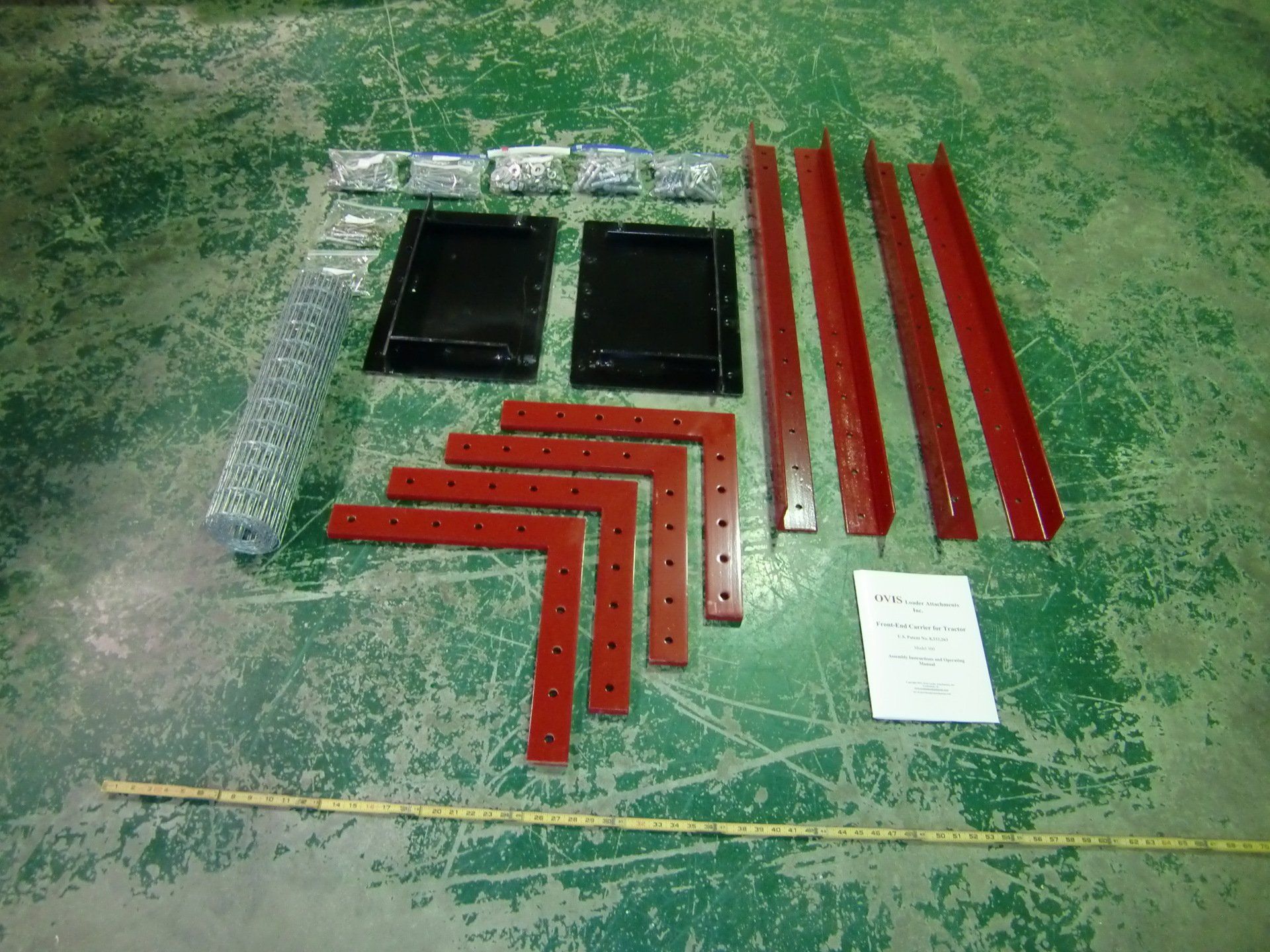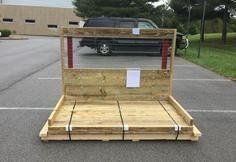Front End Platform Kit ($598 - $968)
Ovis Loader Attachments, Inc. sells the Front End Platform Kit (also known as the Front End Carrier Kit), which is available in four different variations depending on the type of quick attach connection desired. This kit contains primarily the pre-cut, pre-drilled, and powder-coated supporting steel for building a 10'-wide, 8'-wide, or 6'-wide Front End Platform. The required galvanized fasteners and ten pressure-treated boards must be bought locally. Materials in the kit include four steel deck and back supports, all ¼ inch thick and approximately 4 feet long; four L-shaped steel braces, all ¾ inch thick with 2½ inch by 18 inch legs; one heavy gauge steel grill, 2 feet wide and 10 feet long; and (usually) a pair of steel quick attach brackets (left and right). These brackets can be selected to be compatible with skid steer loaders, John Deere Series 200-, 300-, 400-, or 500-series loaders, or for use with a fork attachment on any type of loader. The kit also includes a detailed list of boards and fasteners to be bought locally, detailed assembly instructions with photographs, a list of tools needed for the assembly, and a manual containing operating and safety instructions.
The assembly can be done using common tools and skills for someone who owns a tractor, and can be done by one person working alone or by two people, in about a half day. The assembly primarily involves measuring and cutting boards, positioning boards and steel, drilling holes in boards in positions dictated by holes in the steel supports, and fastening components using bolts and screws. The retail cost of the boards is currently about $230 for the 8 foot wide model and about $270 for the 10 foot wide model.
Selling kits instead of completely assembled units yields two important kinds of savings for the customer. First, it obviously eliminates our manufacturer's labor cost for the assembly (although this labor must now be carried out by the customer). Second, it results in a savings of about $200 due to a much smaller shipping or delivery cost. The components are shipped on a single pallet, approximately 48" by 36". Note that the great majority of the material cost of a Front End Platform is in the steel components, all of which are included in the kit. Because of our volume ordering, we are able to produce the steel components at a greatly reduced price, including cutting, welding, drilling, and powder coating.

Finished Implements
Following are three sizes of finished implements that can be built using the Front End Platform Kit and lumber bought locally. The 8-foot wide and 10-foot wide models are the most popular. (Actually, other widths between 6 feet and 10 feet can be chosen.) The Users Manual describes the assembly process. The weights given are for the completely assembled implement (with wood).


Design Considerations and Details
- The Front End Platform attaches to the hydraulic system of a front-end loader on a tractor or similar vehicle, alternating with the bucket as desired. It consists primarily of a horizontal deck and a vertical back, with very small sides.
- It is 4 feet deep and 4 feet high, and has a recommended width of 10 feet, 8 feet, or 6 feet. The 10-foot model has approximately the same capacity, in area and volume, as a full size pickup truck with an 8 foot bed.
- The Front End Platform is rated to hold 1200 pounds spread uniformly over its deck. (Actually, it has been tested to hold one ton (2,000 pounds) of material spread uniformly over its deck.) The Platform can be lifted and tilted by the front-end loader system, just as the system would do with its conventional bucket attachment.
- The sturdy grill in the upper part of the back provides better visibility for the driver. The very small sides make the Platform very suitable for carrying material that is much longer than the width of the Platform, such as limbs, lumber, logs, brush, boards, pipes, poles, plywood, sheetrock, etc. By contrast, the sides of a bucket, while necessary for its strength, make the bucket quite inefficient for carrying material longer than its width, because the material would have to rest on the top edges of the sides.
- The use of powder coated steel, galvanized fasteners and grill, and pressure treated wood means that the Platform can be stored outdoors. Our original prototype was created in 2010 and is still in excellent condition after being kept outdoors almost all of the time.
- The design of the Platform is extremely efficient, offering maximal performance for minimal cost. The steel, wood, and grill have excellent strength and stiffness, to support the many uses of the implement.
Why Use Wood Decking
The main boards comprising the deck and back are 2"×12" boards, either 10', 8', or 6' long. They have been chosen because of their strength, stiffness, durability, cost, weight, and ease of fabrication. While the wood components constitute the majority of the implement by volume, they comprise only about 20% of the material cost, thereby greatly reducing the overall cost of the implement while maintaining its strength and functionality.
Most people assume that tractor implements must be made entirely or almost entirely of steel. The reason for using steel is that it is the ideal material for withstanding the forces and stresses sustained in equipment such as buckets, brush hogs, blades, disks, etc., which are used for scooping, mowing, scraping, cutting, digging, etc. However, the functions of the Front End Platform are lifting, carrying, and dumping, which incur much different kinds of force and stress. The stresses on the Platform are really more like those on a farm wagon or trailer, than on a brush hog or disk. And of course, farm wagons and trailers often use wood planking. The wood components in the Platform give excellent performance at just a fraction of what the cost would be if steel or another material were used in its place. We are happy to pass that cost savings on to the customer.

